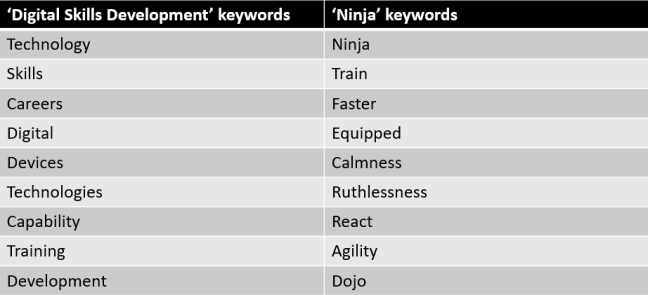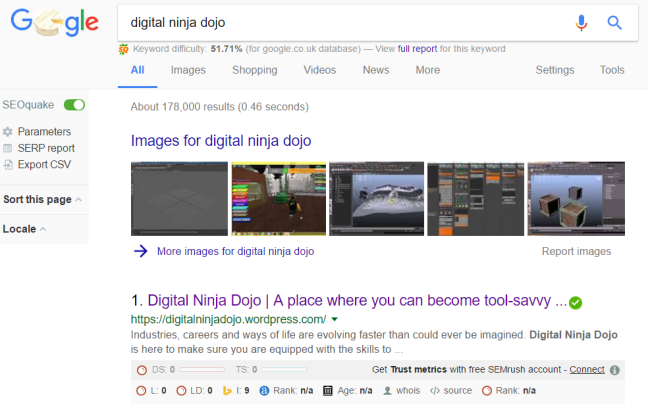Keyword/s, phrases and themes
In SEO (Search Engine Optimisation), there is a common belief that if you think about the words people use to search and include them in your page, that it will rank better. However, according to Williams (2016) this guideline was more relevant before the Panda update was released for Google’s search engine in February 2011; Panda deters webmasters from optimising their webpages for search engines at the expense of visitor experience. Instead, Williams suggests focusing on the synonyms of those keywords and what the searchers intent is.
I have carefully incorporated words which are associated with ‘digital skills development’, as well as ‘ninja’ themed words to help with building the organisations brand:

I identified these words by analysing SERP’s (search engine results page), before using a tool called SEO Quake to quickly audit the top search results and view keyword/phrase densities.
Adhering to Google’s Webmaster Guidelines was an important part of content creation, not to rank high in search results, but so that the content would come across as professional and deliver value to visitors.
Target audience and influence on content
People are naturally uncomfortable with change so I wanted to create content that would engage a broad audience until further visitor analysis can be performed; by getting them interested and providing next steps to help them on a journey of digital skills development. To do this, I consciously included an impactful info graphic and a clear call to action.
The info graphic brings to life the exponential rate at which technology is advancing and makes the point that skills required to operate in such an environment are also evolving and people must adapt. This then leads to a series of questions for the visitor, prompting them to think about whether they are equipped to deal with this level of change at work and in life. If the answer was yes to any of these questions, the visitor is encouraged to sign up and become a member via the subscription box.
On page SEO techniques
SearchEngineLand (2015) suggests that there are several ranking factors and best practises that can lead to success when optimising on page content for users and search engines, where architecture and HTML play an important role.
Architecture
Google uses software often referred to as ‘crawlers’ or ‘Googlebot’ to index content across the web so that it can be stored and ranked by the search engine algorithm. Therefore, it is important that crawlers have access to all relevant web pages, this is controlled through a file called ‘robots.txt’.
The Digital Ninja Dojo robots.txt file contains the following:

This is an effective configuration as it allows crawlers access to all the main pages, but blocks the crawler from scanning administration pages that do not need indexed or ranked by the search engine.
There are other reasons why you may want to disallow content to a crawler. If a page is under development, has a lot of outbound links, old content or private information, a webmaster may want to disallow those pages in the robots.txt file. Otherwise, there is a risk the crawler views the content as suspicious, spam or evidence of duplicate content (Ledford, 2008). This is something I will need to bear in mind whilst developing new content.
HTML
Titles and meta descriptions are extremely useful HTML elements that can be used to help Google’s algorithm index and represent a website in the most effective way.
Any one piece of content may have the same title as hundreds of others, which is why it’s very important to craft a title that is unique and descriptive. For this site, the main content has been titled ‘Train like a ninja for exponential change’. This helps to grab visitor attention by suggesting it is something they have not seen before.

Meta descriptions allow a webmaster to suggest how a page will be described in search results. Above is the SERP for Digital Ninja Dojo, keywords are included in the meta description to reassure visitors they have found a site that contains relevant content.
Behavioural insights
Having researched keywords that people might use to come across the Digital Ninja Dojo. There is another method of optimising the site for customer experience, that is through behavioural insights. Krug (2006) suggests there is no stereotypical web user, but Chaffey (2008) has demonstrated that visitors tend to fall into three behavioural categories: explorers, hunters and trackers.
Explorers use a few key words to start searching against a topic of interest, such as ‘digital skills’. They tend to be click happy and therefore need a website to have simple navigation with easy to read content.
Hunters have a better idea of what they are looking for and may search for a key phrase such as ‘learning how to code for careers in digital’, they may even have a programming language in mind.
Trackers know exactly what they are looking for and have generally been through the process of exploring and tracking. Now they just need to locate the best source of information or company to service their needs.
Digital Ninja Dojo will be optimising content for explorers. This will allow time for the website to build up traffic and perform further analysis on the interests of visitors. I can then create tailored content that is in demand for ‘hunters’ or ‘trackers’.

